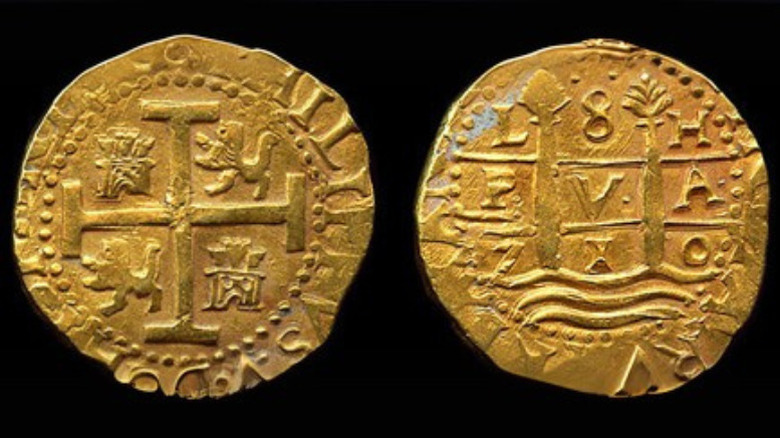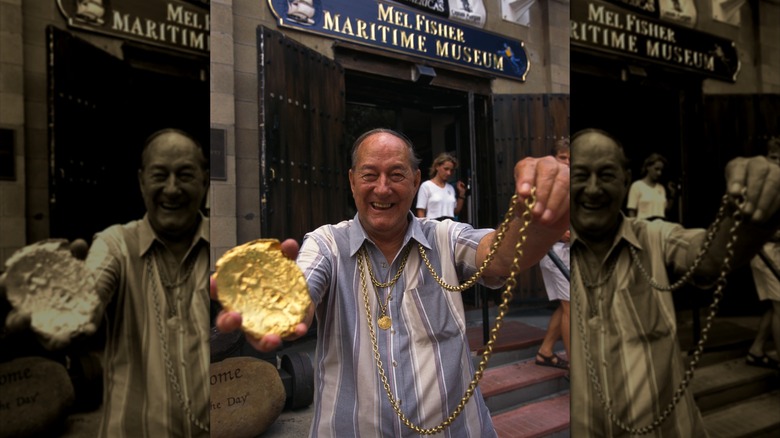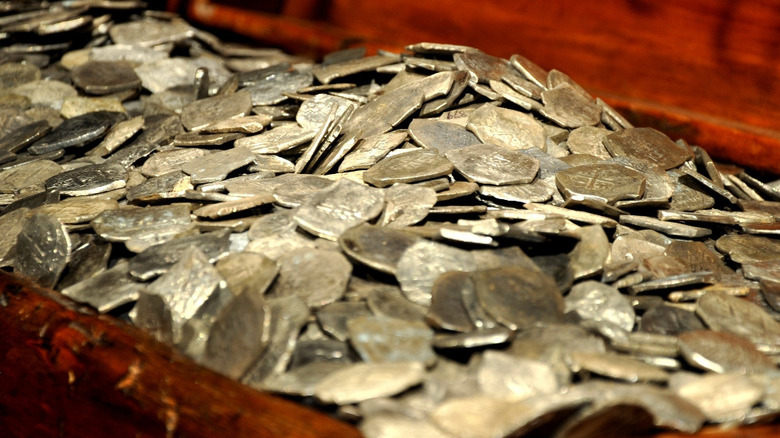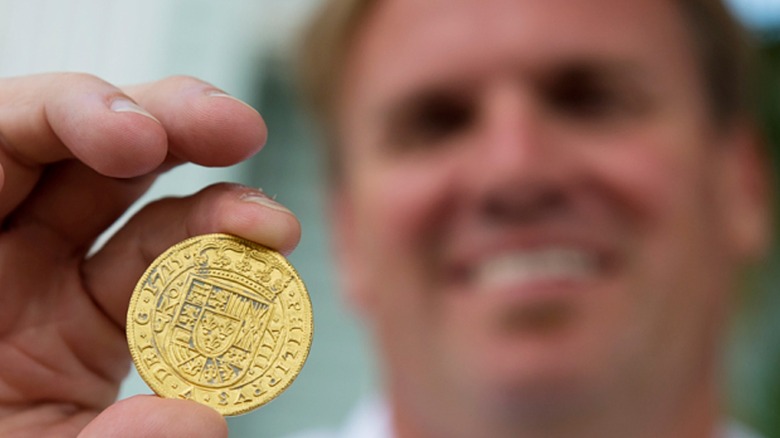Everyday People Who Became Filthy Rich From Shipwreck Treasure
Most people go to the beach looking for seashells, sun, or maybe a decent parking spot. But a lucky few walk away with something a little more sparkly. Like gold doubloons. That actually happened to a building contractor, who stumbled across ancient coins during a weekend stroll in Florida.
The ocean is essentially the world's largest lost-and-found, filled with centuries of maritime disasters. When Spanish treasure fleets met hurricanes, pirate ships got too greedy for their own good, or merchant vessels met one reef too many, they left behind a fortune in gold, silver, and priceless artifacts. Countless shipwrecks and the riches they hold are still out there, just waiting for someone with a metal detector.
Of course, treasure hunting isn't exactly a walk on the beach. It takes persistence, research, expensive equipment, and the willingness to navigate murky waters potentially filled with legal battles, government claims, archaeological interests, cultural concerns, and environmental impacts. But for those willing to take the challenge, the payoff can be extraordinary. It certainly was for a chicken farmer with childhood dreams of diving for treasure and a high school teacher who couldn't shake his uncle's wild stories about pirate ships. They both traded their day jobs for the treasure of the hunt — and it paid off.
A building contractor finds coins worth millions
In 1715, a fleet of Spanish ships filled with gold, silver, and other treasures set sail from Cuba and headed for Spain. The crew had plenty to worry about, like pirates, privateers, and the unpredictable weather. Unfortunately, it was the last one that sealed their fate. A deadly hurricane ripped through the fleet, drowning 11 of the 12 ships. Hundreds of sailors were lost. Boxes of treasure, measured in literal tons, sank into the ocean.
It was a couple of centuries later when Kip Wagner, a building contractor from Ohio, traveled to the Sunshine State to build a motel. On the weekends, Wagner enjoyed strolls along the shore, where he learned that Florida beaches were a treasure trove for long-lost relics. He found old silver and gold coins, all dated from 1715 or earlier. Curiosity piqued, and after a bit of research, Wagner learned about the 1715 fleet shipwreck. He promptly borrowed an army metal detector. With the help of his new tool, he found more coins, along with silver chunks, a diamond, a gold ring set, Chinese porcelain, and Mexican ceramics.
By the early 1960s, Wagner had recruited more help, including a boatman and a diver. The team found thousands upon thousands of silver coins, gold coins, emeralds, swords, daggers, and enough artifacts to make Indiana Jones jealous. The massive discovery totaled over $3.5 million, turning Wagner from a motel contractor into one of the most famous treasure finders of the 20th century.
A chicken farmer becomes a treasure-finding legend
With a bucket as a makeshift helmet, Mel Fisher spent his childhood in Indiana "diving" for treasure in gravel pits. Eventually, he moved to a California chicken farm with his parents. And on that farm, there was a shed. That shed became the site of Fisher's first dive shop.
When Fisher married his wife, Dolores "Deo" Horton, they celebrated their honeymoon in Florida by diving for shipwrecks. Back in California, the couple funded their dreams by diving for lobsters and eventually opened a popular dive shop in Redondo Beach. But the call of treasure was strong, and soon they packed up and moved to Key West, Florida, where they lived on a shabby houseboat. But it was a profitable move...
In 1980, Fisher located the Santa Margarita, one of the most spectacular shipwreck treasures ever found. But that would be topped in 1985, when Fisher's son helped discover the Nuestra Senora de Atocha. Both ships, carrying heavy loads of gold and silver, went down in a hurricane off the Florida Keys in 1622. The Atocha alone held 47 tons of gold and silver. It's hard to really know just how much the total treasure is worth, but Fisher estimated the value at around $400 million. He used some of his fortune to open the non-profit Mel Fisher Maritime Museum, helping to preserve and study the artifacts he uncovered.
A former teacher owns a pirate ship
As a kid, Barry Clifford listened to his Uncle Bill spin wild tales about a treasure-filled pirate shipwreck just off the coast of Cape Cod. As an adult, Clifford taught high school and coached football. But Uncle Bill's story stuck around. So, in the 1970s, Clifford swapped chalkboards for dive gear and started a salvage-diving business. In 1984, he discovered the wreck of the Whydah, one of the most famous pirate ships in history.
Pirate captain Samuel Bellamy overtook the Whydah, which was originally built to transport enslaved people. Bellamy used the big and fast Whydah to loot over 50 ships. In 1717, full of all that treasure, the pirate ship headed for Cape Cod. But it never made it. A fierce cyclone sank the Whydah just off the coast of Massachusetts. Bellamy and most of his crew went down with the ship.
When Clifford and his team located the wreck, they found everything from navigational instruments and ancient coins to sparkling jewels and Bellamy's personal pistol. Experts estimate the treasure to be worth around $100 million. After years of legal battles that reached Massachusetts's highest court, Clifford won full title to the shipwreck in 1988. He even gained the power to keep other would-be treasure hunters out of the area, an important provision since it's believed that only 10% of the ship's belongings have been recovered. Much of what has been found is on display at Clifford's Whydah Pirate Museum.
From real estate to real treasure
Before he was hunting for gold, Brent Brisben was flipping houses. But eventually, he flipped careers and became operations manager for 1715 Fleet Queens Jewels, LLC. The company holds the rights to salvage the legendary Spanish fleet that sank off the Florida coast. Brisben's role as Operations Manager didn't mean he'd stay dry in some stuffy office. Every summer, he went out with a group of sunburned optimists to search for sunken riches. Speaking to CNN, he compared his job to looking for a "needle in a haystack." Sometimes, he actually found a needle.
In 2010, Brisben and his team unearthed a jackpot of over a million dollars' worth of treasure. The bounty included a bronze cannon, gold and silver coins, and a rare gold artifact that quickly caught the eye (and wallet) of a private collector. Three years later, they found about $250,000 worth of gold coins dating back to 1697. Under 1715 Fleet Queens Jewels' agreement with the state, Florida gets 20% of whatever is found. Some of what's left is sold to collectors to help bankroll future dives.
The most prized needle was found in 2015, in the form of 350 Spanish gold coins valued at $4.5 million. The find included rare "Royals" coins, each worth around $300,000. That coin type hadn't been found since 1998. You never know when or what will be found next — Brisben estimates there's still about $400 million in treasure from the 1715 shipwrecks waiting on the ocean floor.




